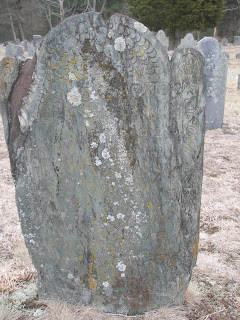Thomas Cushman was born about
September 1637 in Plymouth, Mass., the son of Thomas Cushman and Mary Allerton.
His mother Mary and grandfather Isaac came to Plymouth on the Mayflower. His birth was
not recorded, but his father Thomas named him in his 22 October 1690 will. I wrote about Thomas and Mary Cushman here.
On 7 March 1664/5 Thomas
Cushman was fined by the Plymouth Court for committing "carnal coppulation" with
his now wife before marriage, but after contract.
Thomas married Ruth Howland on
17 November 1664 in Plymouth. Ruth was born circa1646 in Rocky Nook, now
Kingston, Mass., the daughter of John and Elizabeth (Tilley) Howland. Both of
Ruth’s parents came to Plymouth on the Mayflower.
Recently I toured the Jabez
Howland house at Plymouth. Jabez was Ruth’s brother and she certainly would have
visited him there. The historic house has a collection of items excavated from
the Rocky Nook, Kingston, home of Ruth’s parents. Does anyone else get chills to
see items that your ancestors used hundreds of years ago? Thankfully there are
organizations like the Pilgrim John Howland Society that do so much work to
preserve the memory of our ancestors.
 |
| Jabez Howland house in Plymouth |
Thomas and Ruth had three
children:
Robert born 4 October 1664; m.
1st Persis Lewis and 2nd Prudence Sherman; lived Kingston,
MA
Desire born about 1668; m.
Samuel Kent; lived Barrington, RI (Desire Cushman was named in her grandmother
Elizabeth Howland’s 17 December 1686 will)
Thomas born about 1670; m.
Sarah Strong; lived Lebanon, CT
I descend through Robert and
his first wife Persis.
Ruth died before 16 October
1675 when Thomas remarried. I would guess she is buried at Old
Burial Ground (aka Hillcrest Cemetery), Plympton, but her stone has not survived. There is a stone erected to
the memory of Ruth and the rest of her siblings at Burial Hill in Plymouth,
which I also visited recently.
 |
| Memorial marker in memory of Ruth and her siblings, Burial Hill, Plymouth |
Thomas married, second, Abigail (Titus) Fuller on 16 October 1675 at Rehoboth, Mass. They had four children: Job, Bartholomew, Samuel, and Benjamin.
On 16 April 1679 Elder Mr.
Fuller and Brother Thomas Cushman were chosen to attend the ordination of Mr.
Samuel Angier at the Rehoboth Church. On 24 October 1694 Thomas again went with
the pastor to the ordination of Mr. Thomas Greenwood at the Rehoboth Church. On
11 September 1692 the church met to consider names of men who could read the
psalms during Deacon Faunce’s illness, and Thomas Cushman was one of the men
chosen. It seems that Thomas's earlier misstep did not hurt his standing in the church, although he did not reach the level of his father as Ruling Elder of the Church or his brother Isaac who was a minister.
Thomas Cushman was on the list
of members of the Plymouth Church on 10 March 1703 with a notation he was
dismissed, but does not say to what church.
On 1 March 1714/15 Thomas
Cushman of Plympton sold land to his son Robert Cushman. On 22 June 1715 Thomas
Cushman of Plympton, yeoman, sold land to son Job Cushman.
On 21 May 1721 Thomas Cushman
of Plimpton, yeoman, deeded to son Benjamin the house and land where Benjamin
was living. On the same day he deeded to son Samuel the land where Samuel was
living. On 25 Dec 1721 he deeded the land where he himself was living to sons
Benjamin and Samuel.
Thomas died 23 August 1726 at
Plympton, Mass. He was age 80 “wanting a month.” He is buried at
the Old Burial Ground in Plympton, but his gravestone is worn and difficult to read.
.
Here Lies ye Body of Mr. Thomas
Cushman
Dec Augst ye 23rd
______________________
No Plymouth County probate has
been found for Thomas.
Sources Not Listed
Above:
Eugene Stratton, Plymouth Colony, It's
History and People, 1986
Robert S. Wakefield and
Margaret Harris Stover, Mayflower Families Through Five Generations, Isaac
Allerton, Volume 17, compiled by, Published by GSMD, 1998
Ann Smith Lainart and Robert
Wakefield, Mayflower Families Through Five Generations, John Howland, Vol
23, Part 1, GSMD, 2006











